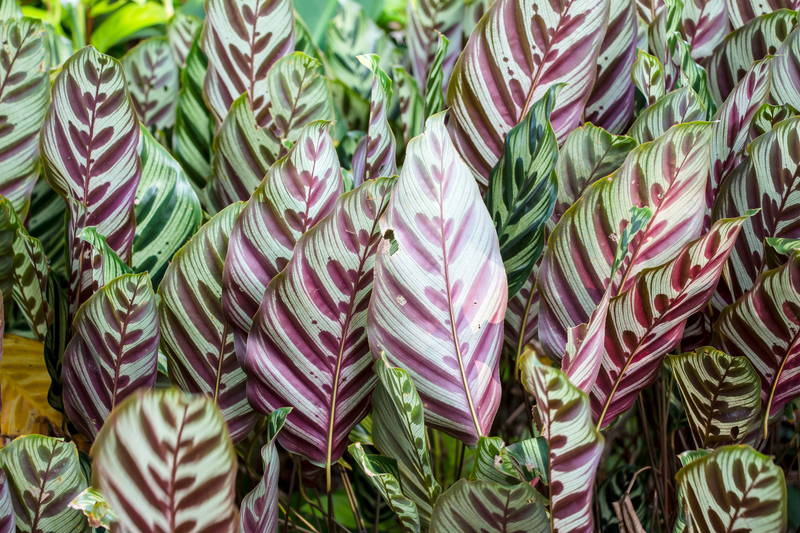Elevate Your Landscape: Hedge Trimming Shapes and Methods
Posted on 25/06/2025
Elevate Your Landscape: Hedge Trimming Shapes and Methods
Maintaining a pristine landscape requires more than just mowing the grass and planting flowers. The art of hedge trimming is pivotal in creating breathtaking gardens and elevating your landscape to new heights. With the right hedge trimming shapes and methods, your landscape can transition from ordinary to extraordinary, reflecting not only beauty but also meticulous care and design prowess. Whether you are a gardening enthusiast or a landscaping professional, understanding various hedge-trimming techniques can drastically enhance your outdoor environment.

Understanding Hedge Trimming: Why It Matters
Before delving into the specifics of hedge shapes and trimming methods, it's essential to recognize why this practice is so important:
- Improved Aesthetics: Well-maintained hedges add structure, depth, and visual appeal to any landscape.
- Plant Health: Correctly timed and executed trimming encourages robust growth and prevents disease.
- Functional Benefits: Hedges provide privacy, noise reduction, and even wind protection when properly shaped.
- Increased Property Value: A tidy, well-designed landscape with artistically-shaped hedges can elevate a property's worth.
Now, let's dive deeper into the fascinating world of hedge trimming shapes and methods to maximize your landscape's potential.
Common Hedge Trimming Shapes to Enhance Your Garden
Hedge shaping is as much an art as it is a science. From simple geometric lines to elaborate topiary, the right shape can complement your landscape's style. Here are some of the most popular hedge shapes:
1. The Formal Rectangle or Square
This classic shape is synonymous with symmetry and order. The rectangular hedge serves as an architectural backbone in traditional gardens and is ideal for borders, walkways, and property lines.
- Best for: Boxwood, Privet, Yew, and Holly hedges.
- Trimming tip: Always trim so the base is wider than the top, allowing sunlight to reach lower branches and preventing thinning.
2. Rounded or Curved Hedges
For a softer look, opt for rounded hedge shapes. These curved silhouettes blend naturally with flowerbeds and rolling landscapes, promoting a harmonious feel.
- Encourages natural light penetration to the entire shrub.
- Ideal for foundation plantings and creative garden edges.
3. Sloped or Angled Hedges
Sometimes known as the "A-line" trim, an angled hedge maintains its fullness by ensuring the base receives adequate sunlight. The sides are subtly sloped, balancing aesthetics and plant health.
- Prevents shadowing and dieback at the hedge's base.
- Useful for: Formal and semi-formal gardens.
4. Topiary Art: Creative Hedge Trimming
For those seeking a dramatic statement, topiary shapes--which mold hedges into spirals, animals, and abstract forms--showcase artistic flair and mastery.
- Subject to: More frequent and detailed maintenance.
- Best suited for: Box, Yew, and Ligustrum species.
- Tip: Start simple if you're new to topiary artistry!
5. Naturalistic or Free-Form Hedges
Natural hedges embrace the plant's own growth habit, offering a relaxed, organic look. While still maintained for health, these hedges are less rigid in shape.
- Favors wildlife and biodiversity.
- Requires less frequent trimming--but careful selection of shrub variety is essential.
Best Hedge Trimming Techniques: Methods for Lasting Results
Choosing the right hedge cutting technique depends on the plant species, desired shape, and your garden goals. Let's unravel the most effective trimming practices for a healthy, beautiful hedge.
1. The Shearing Method
Shearing uses long-bladed manual hedge shears or powered trimmers to cut multiple stems simultaneously, producing a smooth, uniform surface. It's widely used for formal shapes.
- Pros: Fast and efficient for straight lines and geometric patterns.
- Cons: May result in "green shells" with sparse inner foliage if overdone.
- Tip: Alternate shearing with selective pruning for thickness.
2. Selective Pruning (Thinning)
This technique involves individually removing stems with hand pruners. By reducing density inside the hedge, it improves air circulation and light penetration.
- Ideal for: Naturalistic hedges, flowering shrubs, and rejuvenating old or overgrown plants.
- Encourages: Healthy, bushy regrowth--making your hedge denser over time.
3. Rejuvenation Pruning
Heavily overgrown or neglected hedges can often be restored with rejuvenation pruning. This drastic cutback stimulates brand new growth.
- Method: Cut back hardest in late winter or early spring before new growth emerges.
- Note: Certain species respond better than others--research your plant first.
4. Annual Trimming
Routine hedge maintenance through annual or biannual trimming keeps your hedges dense and healthy.
- Encourages compact growth and maintains your chosen hedge form.
- Timing varies by species--spring and late summer are common periods.
5. Shaping With Tools
Hedge trimmers, shears, and loppers each play a unique role. Know when to use powered tools versus manual pruners for precision versus speed.
- Powered trimmers: Perfect for large, uniform hedges.
- Hand shears: Better control for topiary and finishing touches.
- Loppers: Essential for thick branches and rejuvenation cuts.
Practical Tips for Achieving Perfect Hedge Shapes
Bringing your hedge design ideas to life takes skill and practice. Here's how to ensure your hedge trimming methods produce professional results:
- Mark Your Lines: Use taut string, stakes, or cardboard templates to guide straight or curved shapes. This is especially helpful for geometric designs and topiary.
- Start At The Top: Trim the hedge's upper surface before moving to the sides. This prevents falling debris from distorting your lines.
- Work From Bottom Up: For sloped or angled hedges, start at the base and move outward to refine the shape.
- Step Back Frequently: Regularly assess your handiwork from a distance for symmetry and alignment.
- Sharpen Your Tools: Well-maintained blades make cleaner cuts and minimize plant stress and disease.
Common Hedge Trimming Mistakes and How to Avoid Them
Even experienced gardeners can make errors while shaping their hedges. Avoid these pitfalls to keep your landscape in peak condition:
- Cutting at the Wrong Time: Trimming during active growth (for flower or berry-producing shrubs) can reduce blooms. Know your plant's cycle.
- Over-trimming: Removing too much foliage stresses the plant and can cause bare spots.
- Trimming Too Narrow at the Base: When a hedge's top is wider than its bottom, the lower branches may die off due to lack of sunlight.
- Ignoring Plant Health: Always sterilize blades to prevent the spread of disease, and look out for pest problems.
- Uniform Height, Uneven Ground: Use a level or string lines on sloping terrain to maintain even height across the entire hedge.
Safety and Sustainability in Hedge Trimming
- Wear Protective Gear: Safety glasses, gloves, and appropriate footwear are essential when using sharp tools or power equipment.
- Be Mindful of Wildlife: Check for nesting birds and insects before trimming, especially during spring and summer.
- Recycle Clippings: Compost trimmed branches and leaves, or use them for mulch to promote a sustainable landscape.
- Eco-Friendly Tools: Where possible, use manual trimmers or electric models to reduce noise and carbon emissions.
Choosing the Right Hedge Species for Shape and Maintenance
Not all shrubs are suitable for complex shaping. Choose evergreen or semi-evergreen species for consistent color and density, and match plant selection to your desired hedge trimming forms:
- Best for Formal Hedges and Topiary: Boxwood (Buxus), Yew (Taxus), Privet (Ligustrum), Holly (Ilex)
- Best for Informal or Flowering Hedges: Forsythia, Viburnum, Escallonia, Spirea, Rose
- Fast-Growing Privacy Screens: Leyland Cypress, Arborvitae, Photinia, Cherry Laurel
Tip: Research your local climate and soil conditions. Native species often require less maintenance and support local wildlife.
Seasonal Considerations for Hedge Care
The timing of your hedge cutting routine plays a pivotal role in its success:
- Spring: Prune deciduous hedges before leaf-out. For evergreen species, light shaping is ideal.
- Early Summer: Main trimming period for rapid growers and topiary work.
- Late Summer: A final trim encourages neatness heading into fall.
- Winter: Major rejuvenation work can be done on dormant hedges, but avoid in areas of severe cold or with species sensitive to heavy pruning.

Innovative Hedge Trimming Trends
Modern landscaping has brought new creativity to hedge shaping:
- Living Walls: Vertical hedges that serve as privacy or decorative green screens, perfect for urban landscapes.
- Wave and Cloud Pruning: Japanese-inspired techniques that create undulating forms resembling waves or clouds.
- Mixed-species Hedges: Combining multiple types of shrubs for a tapestry of textures, shapes, and colors.
- Edible Hedges: Using fruiting shrubs like blueberry, gooseberry, or currant for both ornamental and culinary delight.
Conclusion: Transform Your Outdoor Space with Impeccable Hedge Design
Elevating your landscape through hedge trimming is a rewarding blend of horticulture and art. By selecting appropriate hedge trimming shapes and refining your cutting methods, you not only enhance your garden's design but also support plant health and ecosystem balance. Whether you dream of intricate topiary, tidy lines, or natural living walls, the knowledge and tips shared here will help you achieve a polished, professional look in your own backyard.
Start planning your next hedge-trimming project today, and watch your landscape blossom into a masterpiece of shapes, forms, and lush greenery.

